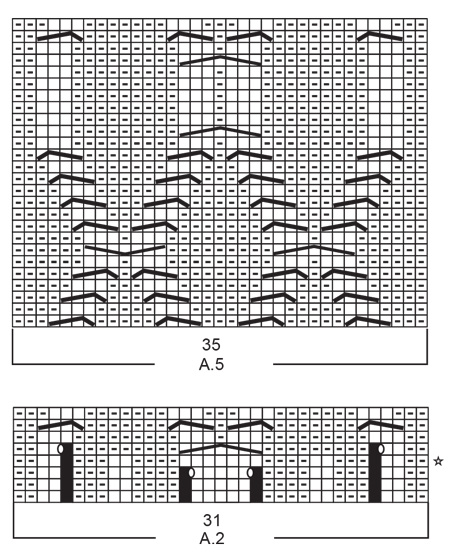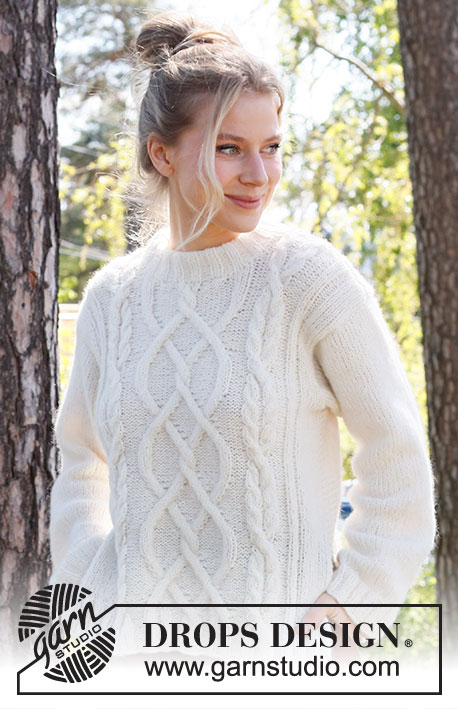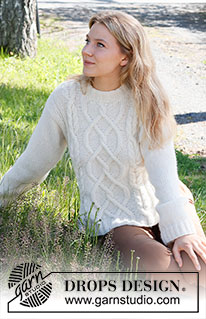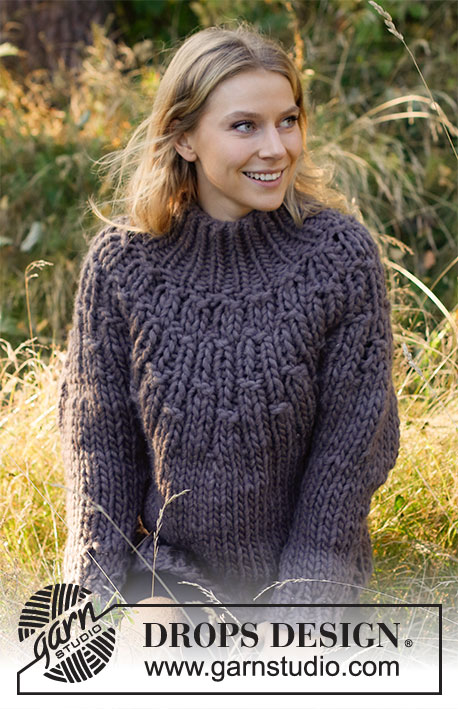Seafarers Heart |
||||||||||||||||||||||||||||||||||||||||
 |
 |
|||||||||||||||||||||||||||||||||||||||
Knitted jumper in DROPS Air. The piece is worked with cables. Sizes S - XXXL.
DROPS 216-10 |
||||||||||||||||||||||||||||||||||||||||
|
------------------------------------------------------- EXPLANATIONS FOR THE PATTERN: ------------------------------------------------------- RIDGE/GARTER STITCH (worked back and forth): Knit all rows. 1 ridge in height = Knit 2 rows. PATTERN: See diagrams A.1 to A.6. DECREASE TIP-1 (evenly spaced): To work out how to decrease evenly, count the total number of stitches on needle (e.g. 10 stitches) and divide by number of decreases to be made (e.g. 4) = 2.5. In this example decrease by alternately knitting together each 1st and 2nd stitch and each 2nd and 3rd stitch. DECREASE TIP-2: Decrease evenly – read DECREASE TIP-1 by purling 2 stitches together where you have purled or knitting 2 stitches together where you have knitted. INCREASE TIP: Work until there are 2 stitches left before the marker thread, 1 yarn over, knit 4 (marker thread sits between these 4 stitches), 1 yarn over. On the next round knit the yarn overs twisted to avoid holes. Then work the new stitches in stocking stitch. ------------------------------------------------------- START THE PIECE HERE: ------------------------------------------------------- JUMPER – SHORT OVERVIEW OF THE PIECE: The front and back pieces are worked separately, back and forth on the needle. The sleeves are worked with double pointed needles/short circular needle as far as the armholes. The sleeve cap is then finished back and forth. The neck is worked back and forth from top of shoulder. BACK PIECE: Cast on 99-107-115-123-139-147 stitches (including 4 edge stitches on each side) with circular needle size 4.5 mm and Air. Purl 1 row (= wrong side). Now work rib as follows: 4 stitches in GARTER STITCH – read description above, rib (= knit 2, purl 2) over the next 12-16-20-24-32-36 stitches, knit 2, work A.1 over the next 16 stitches, A.2 over the next 31 stitches, A.3 over the next 16 stitches, rib (= knit 2, purl 2) over the next 12-16-20-24-32-36 stitches, knit 2 and 4 stitches in garter stitch. Continue back and forth like this and repeat the first 2 rows in the diagrams until the rib measures 5 cm – adjust so the next row is from the right side. Now continue with the next 2 rows in A.1, A.2 and A.3, working as before over the other stitches. When you have finished the row with the star, change to circular needle size 5.5 mm and work pattern as follows from the right side: 4 stitches in garter stitch, stocking stitch over the next 10-14-18-18-26-30 stitches, decreasing at the same time 4-5-5-5-8-8 stitches evenly spaced – read DECREASE TIP-1 (= 6-9-13-13-18-22 stitches in stocking stitch), purl over purl and knit over knit over the next 4-4-4-8-8-8 stitches, continue with A.1, A.2 and A.3, knit over knit and purl over purl over the next 4-4-4-8-8-8 stitches, stocking stitch over the next 10-14-18-18-26-30 stitches, decreasing at the same time 4-5-5-5-8-8 stitches evenly spaced (= 6-9-13-13-18-22 stitches in stocking stitch) and 4 stitches in garter stitch. Continue this pattern. When the diagrams have been completed in height there are 95-101-109-117-127-135 stitches on the needle. Now work A.4 over A.1, A.5 over A.2 and A.6 over A.3. The other stitches are worked as before. REMEMBER THE KNITTING TENSION! When the diagrams have been completed, repeat the pattern in height. When the piece measures 35-36-37-38-39-40 cm, cast off stitches for the armholes on each side as follows: Cast off 3-4-5-6-6-7 stitches 1 time, 2 stitches 1-1-2-2-3-3 times and 1 stitch 1-1-1-2-3-4 times = 83-87-89-93-97-101 stitches. Continue the pattern with 1 edge stitch in garter stitch on each side. When the piece measures 52-54-56-58-60-62 cm, work the next row from the right side as follows: Work as before over the first 26-28-29-30-32-34 stitches, knit over knit and purl over purl over the next 31-31-31-33-33-33 stitches, AT THE SAME TIME as you decrease to 23-23-23-25-25-25 stitches – read DECREASE TIP-2 (= 8 stitches decreased), work as before over the next 26-28-29-30-32-34 stitches = 75-79-81-85-89-93 stitches. On the next row cast off the middle 23-23-23-25-25-25 stitches for the neck and each shoulder is finished separately. On the next row from the neck cast off 1 stitch for neck = 25-27-28-29-31-33 stitches. Continue working until the whole piece measures 56-58-60-62-64-66 cm (the armhole measures 21-22-23-24-25-26 cm). Knit 1 row from the right side where you decrease 4 stitches evenly spaced = 21-23-24-25-27-29 stitches. Cast off. Work the other shoulder in the same way. FRONT PIECE: Cast on and work in the same way as the back piece. When the piece measures 35-36-37-38-39-40 cm, cast off stitches for the armholes on each side in the same way as the back piece. Continue with pattern as before and 1 edge stitch in garter stitch on each side. When the piece measures 48-50-51-53-54-56 cm, work the next row from the right side as follows: Work the first 31-33-34-35-37-39 stitches as before, work the next 21-21-21-23-23-23 stitches as before AT THE SAME TIME as these stitches are decreased evenly to 13-13-13-15-15-15 stitches – remember DECREASE TIP-2 (= 8 stitches decreased), place these 13-13-13-15-15-15 stitches on a thread for the neck and work the last 31-33-34-35-37-39 stitches as before. Each shoulder is finished separately. Continue the pattern and cast off stitches as follows on each row from the neck: Cast off 2 stitches 2 times and 1 stitch 2 times = 25-27-28-29-31-33 stitches. Continue working until the whole piece measures 56-58-60-62-64-66 cm (the armhole measures approx. 21-22-23-24-25-26 cm). Knit 1 row from the right side where you decrease 4 stitches evenly spaced = 21-23-24-25-27-29 stitches. Cast off. Work the other shoulder in the same way. SLEEVE: Cast on 60-60-64-64-68-72 stitches with double pointed needles/short circular needle size 4.5 mm and Air. Knit 1 round, then work rib (= knit 2, purl 2) in the round for 5 cm. Knit 1 round where you decrease 10-9-11-10-12-14 stitches evenly spaced = 50-51-53-54-56-58 stitches. Change to double pointed needles/short circular needle size 5.5 mm. Insert 1 marker at the beginning of the round and work stocking stitch. When the piece measures 9-9-9-9-8-8 cm, increase 2 stitches under the sleeve – read INCREASE TIP. Increase like this every 5-4½-3½3-3-2½ cm a total of 7-8-9-10-10-11 times = 64-67-71-74-76-80 stitches. Continue working until the sleeve measures 43-43-42-40-38-36 cm. Now continue back and forth with stocking stitch and 1 edge stitch in garter stitch on each side, AT THE SAME TIME as you cast off stitches for the sleeve cap on each side as follows: Cast off 4-4-5-6-6-7 stitches 1 time, 2 stitches 2-2-2-2-1-1 times, 1 stitch 0-0-3-4-7-9 times, 2 stitches 3-3-2-2-2-2 times and 4-4-4-3-3-2 stitches 1 time = 28-31-31-32-32-32 stitches. Cast off the remaining stitches. The sleeve measures approx. 50-50-51-50-50-50 cm. Work the other sleeve in the same way. ASSEMBLY: Sew the shoulder seams inside the cast-off edge. Sew the sleeves to the body inside the 1 edge stitch on the body and the cast-off edge on the sleeves. Sew the side seams in the outermost loop of the outermost stitch so the seams are flat – start under the sleeve and work downwards until there is approx. 17 cm left (= split). NECK: Start mid-top of the shoulder with short circular needle size 4.5 mm and Air and knit up 72-80 stitches from the right side around the neck (the number of stitches must be divisible by 4). Work rib (= knit 2, purl 2) in the round for 11 cm. Cast off with knit over knit and purl over purl. Fold the rib at the top of the neck to the wrong side and sew down to give a folded edge. To avoid the neck-edge being tight and rolling down, the seam must be elastic. |
||||||||||||||||||||||||||||||||||||||||
Diagram explanations |
||||||||||||||||||||||||||||||||||||||||
|
||||||||||||||||||||||||||||||||||||||||

|
||||||||||||||||||||||||||||||||||||||||

|
||||||||||||||||||||||||||||||||||||||||

|
||||||||||||||||||||||||||||||||||||||||
|
Have you made this or any other of our designs? Tag your pictures in social media with #dropsdesign so we can see them! Do you need help with this pattern?You'll find tutorial videos, a Comments/Questions area and more by visiting the pattern on garnstudio.com. © 1982-2024 DROPS Design A/S. We reserve all rights. This document, including all its sub-sections, has copyrights. Read more about what you can do with our patterns at the bottom of each pattern on our site. |
||||||||||||||||||||||||||||||||||||||||




















































































Comments / Questions (28)
Beste meneer/mevrouw, In het patroon staat dat ik een aantal steken recht boven recht en averecht boven averecht moet breien. Wat wordt daarmee bedoeld? Is dat de ribbelsteek? Groetjes, Renée Fijlstra
13.03.2024 - 06:03DROPS Design answered:
Dag Renée,
Hiermee wordt bedoeld dat je rechte steken breit boven de steken die op de vorige naald ook recht waren gebreid en averecht over de steken die op de vorige naald ook averecht waren gebreid. (Dus je breit eigenlijk zoals de steken zich voordoen.)
14.03.2024 - 22:10Beste meneer/mevrouw, Ik heb een vraag over het patroon: DROPS Design: Patroon nr. ai-283, Seafarers heart. Het gaat om deze zin: Zet 99 steken op (inclusief 4 kantsteken aan elke kant) Wordt er bedoeld dat er 2 steken aan het begin van de naald afgehaald moeten worden en aan het einde van de naald 2 recht breien? Of moet ik een kantsteek extra maken en gelijk beginnen met het patroon? In mijn geval de boordsteek. Groetjes, Renée
28.02.2024 - 15:16DROPS Design answered:
Dag Renée,
Nee, je zet 99 steken op in totaal en daar zitten de kantststeken bij in. Je hoeft dus geen extra steken te maken of steken eraf te halen.
28.02.2024 - 20:18Novost
17.11.2023 - 09:40Med
15.11.2023 - 08:54Novost
14.11.2023 - 19:28Coin
12.11.2023 - 09:35Can this be knitted with 4ply yarn ? How many skeins would it require?
30.10.2023 - 17:25DROPS Design answered:
Dear Mrs Hayden, DROPS Air is a worsted yarn - ,read more here; you can use a 4ply yarn (= yarn group A) but you should then use 2 strands of yarn; use the yarn converter to see the alternatives and the new amount of yarn. Happy knitting!
30.10.2023 - 18:20The actual diagrams are correct in all the cables. I am referring to the diagram instructions. If you look at the instructions next to each diagram, the 4 cable (small one) instructions are opposite to the direction the cable should go. Eg in A.4 the first cable is to the right, but the instructions say to place the 2 sts on the cable needle at front which would result in left cable. Hope this helps explains better. Thank you for your awesome patterns.
02.10.2023 - 10:49DROPS Design answered:
Dear Mrs Steyn, thanks for your feedback, I understand now - our design team will check. Happy knitting!
02.10.2023 - 16:05The diagram instructions for the 4 st cable in A.4 and A.5 are incorrect They have been switched so the first cable in A.4 would go left, when it should go right etc....
27.09.2023 - 14:25DROPS Design answered:
Dear Mrs Steyn, in the large cable in A.4 you will cross the stitches to the right (slip stitches in front of piece) and in the large cable in A.5 they will be crossed to the left (slip sts behind piece) just as shown in diagram and in the last picture. Except if I'm misunderstanding your question.
02.10.2023 - 07:57Beste meneer /mevrouw, Ik wil graag het patroon DROPS 216-10 breien. Ik weet niet goed welke maat ik moet nemen. Ik heb mijn trui opgemeten. Die is 55 cm breed. Nu zou ik maat L moeten nemen. Maar mijn kledingmaat is maat XL. Ik hoop dat u mij kan helpen. Met vriendelijke groeten, Renée Fijlstra
31.08.2023 - 20:41DROPS Design answered:
Dag Renée,
Dan zou je inderdaad maat L aan kunnen houden. Als je van oversized houdt, kun je maat XL aanhouden.
31.08.2023 - 21:35